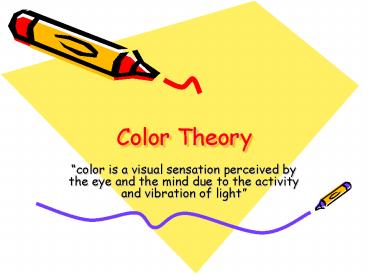Color Theory - PowerPoint PPT Presentation
1 / 33
Title:
Color Theory
Description:
Color Theory color is a visual sensation perceived by the eye and the mind due to the activity and vibration of light General Characteristics Color can create ... – PowerPoint PPT presentation
Number of Views:891
Avg rating:3.0/5.0
Title: Color Theory
1
Color Theory
- color is a visual sensation perceived by the eye
and the mind due to the activity and vibration of
light
2
General Characteristics
- Color can create different moods.
- Color Symbolism people associate colors with
various concepts - A persons culture may influence their
association.
3
Colors of the Spectrum
- Sir Isaac Newton (1666)
- no one color predominates
- colors always appear in the same order ROYGBIV
- colors extend beyond the spectrum
- Infrared
- Ultra-violet
4
Absorption
- the process of taking in, as in a colored object
which absorbs certain rays of light and reflects
other rays giving the object its recognizable
color
5
Reflection
- the return of light waves from surfaces the
bending or folding back of a part upon itself
6
Chromatic Colors
- a color having hue a color of the visible
spectrum (ROYGBIV) - the colors of the spectrum, plus those produced
by their mixtures
7
Achromatic Colors
- a color not found in the visible spectrum a
neutral color such as white, black, gray, and
silver, and gold (for decorative purposes) - the neutral colors
8
Dimensions of Color
- Hue
- Value
- Intensity
9
Hue
- the property of a color by which it is
distinguished from other colors - used only when speaking of the unadulterated
chromatic color - refers to a pure color
10
Primary Hues
- Red
- Yellow
- Blue
11
Warm Hues
- a color which appears in the spectral band,
characterized by long wave-lengths a color which
makes an object appear closer and larger a color
which reflects warmth
12
Cool Hues
- blue, green, purple (AKA violet) or any
intermediate pigmentary hue in which they
predominate a receding hue which creates the
illusion of distance from the observer a color
of short wave-lengths
13
Color Wheels Division into Warm Cool Hues
- Complements directly opposite hues on the
color wheel any two pigmentary hues which, by
their mixture in equal quantities, produce gray
14
Value
- the lightness or darkness of a hue
- every hue is capable of being darkened to a point
above black - every hue is capable of being lightened to a
point below white
15
Intensity
- (chroma)
- the brightness or dullness of a hue
- a pure color is at full intensity
- hues at full intensity are brilliant
- low intensities are soft and pleasant
16
Pigment Theory
- The Prang System
17
Pigment
- a coloring matter which can be applied to an
object, when combined with some type of vehicle - The earliest pigments came from various earths,
minerals, or vegetable dyes.
18
Chemical Pigments
- Range is more narrow.
- Fade or bleach.
- Are not pure colors.
- Are not stable.
- Absorb light rays when they are mixed together.
19
Classes of Hues
- Primary
- Secondary
- Intermediate
- Tertiary
20
Primary Hues
- three pigmentary hues red, yellow, and blue
which can be combined to make all other hues - Cannot be produced by mixtures of other hues.
- Equilateral triangle is the symbol used to locate
the position of the primary hues on the color
wheel.
21
Secondary Hues
- equal mixture of 2 primary pigmentary hues
(orange, green, and purple) - Lie midway between the 2 primary hues which
produce it. - An inverted equilateral triangle depicts the
relationship of the primary and secondary hues.
22
Intermediate Hues
- a pigmentary hue produced by mixing in equal
quantities, a primary hue with its adjacent
secondary hue on the color wheel - Are located midway between the primary and
secondary hues which produce them. - There are 6 intermediate hues.
23
Tertiary Hues
- the hue which results from the mixture of 2
secondary pigmentary hues or an unbalanced
proportion of complements with the warm or cool
hue predominating - 2 families of colors browns and slates
24
Monochromatic Hues
- variations of one hue tints, tones and shades
of one hue
25
Tint
- a hue into which various quantities of white
are mixed - As the quantity of white is increased, the hue is
weakened. - Changes the value of a hue.
- HUE WHITE TINT
26
Tone
- a hue mixed with either a small quantity of gray
or the complement of the hue, resulting in
dulling the hue - Changes the intensity of the hue.
- HUE GRAY (COMPLEMENT) TONE
27
Shade
- a hue into which various quantities of black
are mixed the darkened hue - Changes the value of the hue.
- HUE BLACK SHADE
28
- Once white, black or gray (complement) is added
to a hue, it is no longer a hue, it is a tint, a
tone, or a shade.
29
Analogous Hues
- two or more hues which have the same hue in
common - Are adjacent to each other on the color wheel.
- Contain the same hue.
30
Color Wheel
- a circle in which the primary, secondary, and
intermediate hues are arranged in orderly
intervals
31
Complements
- directly opposite hues on the color wheel
- Always involve a warm hue and a cool hue.
- When mixed in equal parts they result in gray.
- Are the greatest contrast in hues.
32
Juxtaposition
- (simultaneous contrast) any two hues seen
together which modify each other in the direction
of their complements
33
After-image
- psychological a visual impression remaining
after the stimulus has been removed































